Waterproof gloves for sailing
When will somebody invent the first, realio-trulio waterproof gloves?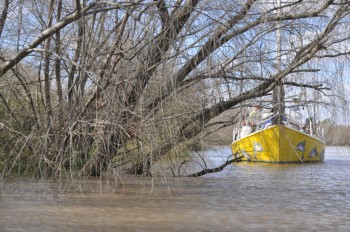
Most yotties don’t sail in the winter. If they’re the sort who have headed off over the horizon they arrive in the tropics and they stay there, travelling like plankton on the kindly winds and currents; and if they’re the kind who are content to cruise their local, European or North American coastline then, come the first frost, they hang up their oilskins and head for the pub.
Indeed, most English yotties flee the water long before the first frost. The equinoctial gales are the predictable grand finale of summer’s pantomime, and before the curtain falls the seasoned salt has already got his craft out of the theatre and snugged her up under a cosy blanket of tightly laced tarpaulins. Most yotties prefer their sailing to be conducted beneath the benevolent gaze of a sultry sun – and with very good reason. Cold weather and water are a deadly combination.
If you fall overboard into cold water you’ve got about ten minutes to get yourself out again before hypothermia sets in. And that’s if the shock of sudden immersion doesn’t send you into a paroxysm of gasping and curtail your ability to breathe. However, that isn’t what we’re talking about here. The first commandment of sailing says, Never Part Company with the Boat and – so far – none of us Mollymawks has ever broken the rule. What concerns us here is not the fate which will befall us should we be so clumsy as to tumble overboard; what concerns us is the more mundane matter of comfort, or its lack.
 Heading south down the coast of Uruguay while the sun, meanwhile, headed north, we were hurrying from summer into winter. Our passage from the Brazilian port of Rio Grande was begun in shorts and T-shirts but we found that we needed to add at least one more layer each day, and by the time we reached the gaping mouth of the Rio de la Plata, at the end of the week, I was clad in a thermal blouse, a long-sleeved shirt, three “fleece” (polyester) jumpers, thermal long-johns, warm trousers, thick woolly socks, knitted leg-warmers, a scarf, a padded waistcoat… and, over the top of that little lot, my chest-high oilskin trousers, furry-lined oilskin jacket, and wellies. This sexy ensemble was topped off with a woolly hat, over which I pulled the oilskin’s capacious hood. And I was still cold!
Heading south down the coast of Uruguay while the sun, meanwhile, headed north, we were hurrying from summer into winter. Our passage from the Brazilian port of Rio Grande was begun in shorts and T-shirts but we found that we needed to add at least one more layer each day, and by the time we reached the gaping mouth of the Rio de la Plata, at the end of the week, I was clad in a thermal blouse, a long-sleeved shirt, three “fleece” (polyester) jumpers, thermal long-johns, warm trousers, thick woolly socks, knitted leg-warmers, a scarf, a padded waistcoat… and, over the top of that little lot, my chest-high oilskin trousers, furry-lined oilskin jacket, and wellies. This sexy ensemble was topped off with a woolly hat, over which I pulled the oilskin’s capacious hood. And I was still cold!
It was an interesting trip in which we experienced everything from calms to a 50 knot squall. And then there was a second squall, during which the glass fell 11 millibars in less than half an hour. That was the one which tore the genoa in two while Nick and Roxanne were trying to furl it.
But I digress. If you noticed the title of this article you will be surely be saying, “And after all that, she’s forgotten to mention her hands!”
As I say, despite being dressed to look like the Michelin man I was still cold. My face was cold; my feet were cold; I was cold at my very core. But nothing about me was so cold as my hands. I daresay that there is nobody on the planet whose hands get as cold as mine do. As I write, the temperature is 22°C (70°F), but I’m wearing a jumper and my hands are cold. When it gets down to 10°C (30°F) my hands basically stop working. And that’s why I say that cold weather and sailing are a lethal combination.
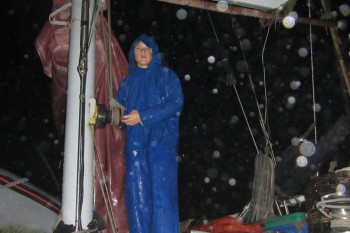
Not everybody has such poor circulation and temperature control as I evidently do, but every person has their cut-off point: the temperature beyond which their extremities cease to function. If you’re sailing a boat and your hands are so cold that you can’t tie a reef knot or undo a rolling hitch, that’s a potentially lethal situation. If you can’t put a reef in the sail or cast off the mizzen boom preventer, or perform one of the many other dexterous deeds which one normally does without thinking, then, to be honest, you’re not much more use than the ship’s dog.
(Hmmm… Well, I guess our dog is not too good at checking our heading or keeping a look-out for ships – we’ve never had much luck in training her to do either of those – so I do exaggerate slightly; but only slightly.)
The best way to keep the core of the body warm is with food. Hot food is good, but any old food will do. I guess the chemistry of sorting it all out into protein molecules and glucose and so forth causes the emission of heat.
I daresay, too, that my layering is inadequate. Before we go further south I will dig out my hand-knitted pure wool jumper. It was bought, many years ago, in South Africa – from a lovely old lady in the Cape Flats – and I’ve never yet worn it without feeling that I could soon drop dead of heat exhaustion; so, it obviously provides far more insulation than the nasty polyester things.
(But it’s also far harder to wash and dry…)
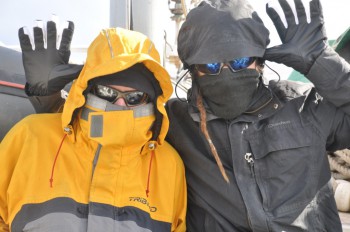
The way to keep the face warm is to cover it. In theory I cover my face with a scarf, but the scarf tends to slide down. A balaclava is a slightly better solution, but even a balaclava is not entirely windproof, and it isn’t at all waterproof. In a gale, with spray flying everywhere, it soon becomes wet; and having become wet it is worse than useless; it actually wicks heat away from the body.
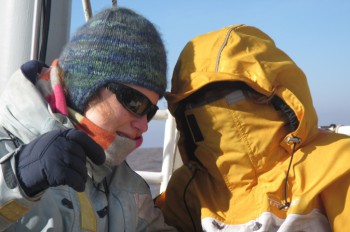
Our old oilies used to feature a removable “visor” as the manufacturers termed it – quite wrongly, it seems to me, since a visor obviously covers the vision. In any event, it was a tall flap, made of the same cloth as the rest of the jacket, which folded across the face and covered everything except the eyes. It would not be at all difficult to retro-fit furry-lined flaps onto our oilskins, and I mean to do so; but in the meantime we’ve found another way to keep the icy cold air off our faces.
With masks!

I guess that any old mask would do so long as it’s waterproof, but we’re fond of these smiling, super-confident faces. I do believe that human beings are affected, at a very deep level, by the expressions on the faces round about them. Hence, “when you smile, the world smiles with you”; and hence, at rallies where the Anonymous mask is worn people tend to be happy and relaxed and (as a result) peaceable. Everybody knows that it’s just a mask, but somehow we find it impossible to cancel out the subterfuge; impossible to believe that behind the visage of a cool dude there might lurk someone aggressive or nervous.
On the other hand, just imagine being greeted at the change of the watch by an ogre! Or, worse still, by Mickey Mouse or Obama…!
As for hands – obviously, the way to keep one’s hands warm is with gloves.
In a gentle breeze, with the boat sailing herself, ordinary knitted gloves will do the job. On such a night you can sit about with your woolly fingers snugly tucked up inside the furry-lined pockets of your oilskin jacket. However, these kind of nights are not so common once you leave the tropics in your wake. In the not-so-temperate Temperate regions stronger winds are the norm, and stronger winds, as we all know, means water flying about that place. Woolly gloves soon soak up the water and become more of a liability than a blessing. Thus, before we headed south we invested in a pair of Gill’s waterproof gloves.
That’s what it says on the website. It says that these gloves feature reinforced grip technology, for reliable performance in wet and dry conditions.
They provide “exceptional warmth and durability.” And they possess a waterproof and breathable liner
.
They also have pre-curved fingers
and a webbing wrist adjustment and draw-cord closure, for the best possible fit and protection
.
The website also says that Gill is a world leading sailing glove brand. It says that this reputation has been earned through constantly researching, designing, and bringing to market gloves that embrace innovation and clever design.
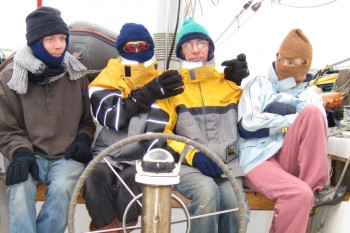
Well… the webbing wrist closure is excellent. One can operate it whilst wearing the gloves. The pre-curved fingers are also a good idea. Since our fingers tend to take up a slightly curled position when relaxed, the pre-curve makes the fit more comfortable. However, this feature is not exactly innovative. Skiing gloves have featured pre-curled fingers for donkey’s years.
The Gill gloves are certainly the warmest I’ve ever worn… but, alas, they aren’t quite warm enough to cope with winter sailing. After an hour or so at the wheel my fingers still become too cold to perform delicate tasks (and this is despite the fact that our stainless steel wheel is insulated with a coach-whipping).
Since the outer shell of the glove is soft, I doubt if it really will prove durable – I doubt if it will cope with hauling on the sheets on a regular basis, and even that coach-whipping, aforementioned, is fairly abrasive – but, of course, I hope to be proved wrong on this score!
The wrist closure is good, as I say, and that’s just as well because, of course, you can’t do fiddly things while wearing these chunky gloves – things like picking up a mug of tea by its handle, or pushing the buttons on the GPS – and so you’re forever taking them off and putting them on again.
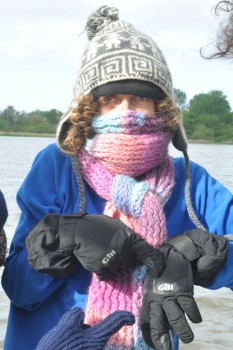
As for the waterproof liner… well, it just isn’t! And this is not because the waterproofing has washed away over time (as does the waterproofing on even the most expensive oilskin jackets). Right from day one these expensive, supposedly waterproof gloves have been permeable to water.
Waterproof, to me, means you can dunk it in a bucket of water. If you can’t – if it will only cope with splashes – then it’s splash-proof. But these gloves aren’t even splash-proof and they never were. I don’t like to use the word liar, but… it’s the one which fits.
Shame on you, Gill! It seems that you haven’t done enough research after all. If you’d like to do some more, with the help of the most demanding cold-handed yotty to be found, drop us a line; I’d be happy to lend a… hand.
In conclusion – I’ve seen cheap skiing gloves which look much the same as these Gill gloves, with pre-curved fingers and velcro wrist closure, and made from much the same materials. In fact, our rasta friend, Gean, has a pair. His mum bought them for him before he came to join us on the Rio de la Plata. Having noticed that Gean’s hands are perpetually warm even when we have been sailing in the rain I suggested that he trying dunking his fingers in a bucket. He did, and they stayed dry.
These gloves cost less than a third of the price of our Gill gloves.
Musto also offer waterproof gloves. They look much the same as the Gill gloves – they’re a little shorter on the wrist, perhaps (and that would count against them, so far as I’m concerned) – and they cost even more: £65 to Gill’s £40. We won’t be trying them, because I’m now tackling the problem from a different direction.
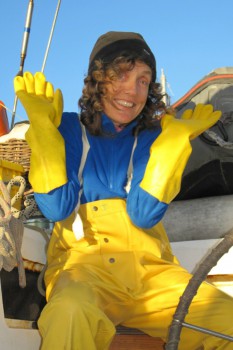
What’s the warmest kind of cloth that you can put your fingers into?
I reckon it’s probably wool; wool, or possibly “fleece” (polyester).
And what’s the most waterproof thing?
That’s an easy one. Plastic is always the most waterproof flexible material.
So, what’s needed is a pair of warm woolly gloves and a pair of super-sized, tough plastic outer gloves.
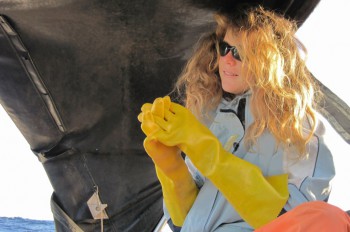

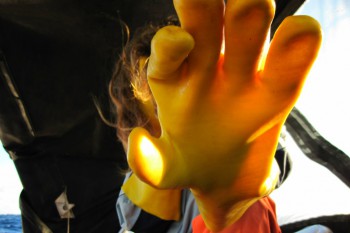
Yes, yes – obviously I look ridiculous wearing them; I look as if I’m about to wash the dishes… in the cockpit, in a force six, with waves slapping down onto the deck. But there’s nobody here to see me. And even if there were, I still wouldn’t care, to be honest. This system works. And it costs a mere fraction of the price for a pair of “the leading sailing glove brand”. (The woolly gloves were made by Thinsulate and are lined with polyester fleece; they came from a builders merchant. The thick plastic outer gloves were given to us by the captain of a fishing boat; they’re the sort used by men long-lining in the Southern Ocean.) I’d always much rather look silly, in something eccentric but effective, than actually be silly in something stylish but useless.
Needless to say, my double-glove system is not perfect. I can steer the boat whilst so attired, but that’s about the limit of my dexterity. In order to sheet in the genny I have to take off both layers. But, since my hands are warm inside the wooly-plastic ensemble, I do still retain the ability to do such things. And after the job is done I can pull everything on and get warmed up again.
The perfect glove would be warm, waterproof, tough, and super-slim, affording the wearer the ability to hoist sails, pick up a fork, and unzip her jeans… but it seems unlikely that this glove will ever be more than the object of night-watch fantasies.
When the weather is especially chilling, so to speak, then much of my time on deck is devoted to this pastime. I run through the possibilities, eventually arriving at heated gloves – “Aha! That’s the answer!”
Well, you can actually buy heated gloves on Amazon… but most of them are heated electrically, and one can imagine how they would get on when suddenly soaked by a passing wave. Reading the reviews, it seems that most brands don’t work very well in the first place.
These people sell a whole range of electrical warm wear. You can have battery operated scarves, battery operated socks… and they even have a pair of heated gloves which feature a special pad on one finger-tip so that the wearer can continue to operate his touch-screen tablet or smart phone… However, as I say, the idea of being wrapped in electrical circuitry whilst also being side-swiped by a salty sea doesn’t appeal to this sailor.
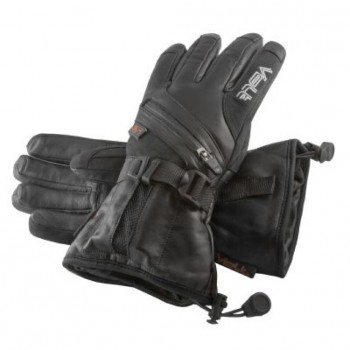
There are, in fact, heated gloves which are advertised as being waterproof but if the folks who are dedicated to making gear for sailors can’t actually come up with the goods then, somehow, I doubt whether a pair of leather motor cycling gloves would fare any better. And I don’t feel like parting with $200 US to prove the point.
Other manufacturers offer mitten-type gloves which are heated by disposable chemical pouches.
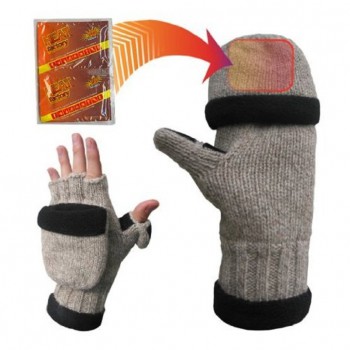
No risk of electric shock or of terminal damage with these gloves; instead the heat is provided by the mixing of charcoal and iron filings.
From some points of view mittens are better than gloves. Whereas gloves isolate each finger from its fellows, mittens allow them to huddle together for warmth. However, from the sailor’s point of view they are not the ideal solution, because they severely restrict one’s ability to do anything.
And, of course, there’s the waterproofing problem again. If one wanted to use these woollen mittens then one would need to create some sort of PVC outer mitten. Or perhaps one could just wear plastic bags…
Then there’s the issue of getting hold of replacement “pouches”.
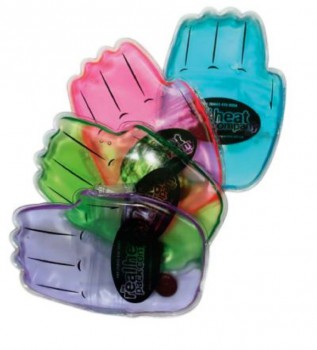
Or how about these hot gel pads, which slip inside your existing mittens? They have the advantage of being reusable, but at $40 US per hand they’re not cheap; and if you don’t already have a pair of waterproof mittens you still have to buy those, too.
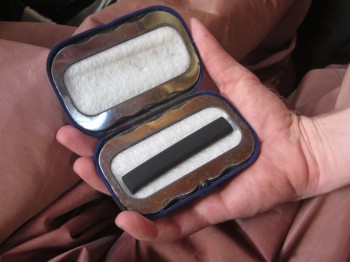
The nearest I’ve come to heated gloves is a device designed, long ago, for huntin’-
I used to carry one of these when I was painting watercolours in the winter. Painting pictures is another thing that can’t be done with gloved hands (too clumsy), and so I would keep the charcoal burner inside the mitten of my left hand and, between laying on the washes, would pass it across to the naked right hand for a brief warm up. How the device would get on cooped up inside a waterproof glove, I can’t say. Probably not too well, because, of course, it does need a small amount of air.
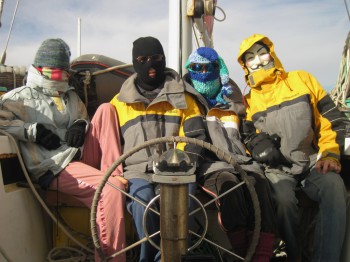
When the south-easter is blowing, ferrying the Antarctic air all the way up to the Rio de la Plata, this place can be shockingly, shiveringly cold. After the sun has rolled away over the horizon, carrying off its warming rays, then a night on the river can be quite an ordeal. The wind blasts my face; my nose begins to feel as if it is frost-bitten; and my eyes begin to run. The cure for the latter is a pair of skiing goggles – but we don’t own any yet.
On nights like this, when the icy air is sucking the heat from my body like a vampire drinking blood, my thoughts turn to other ways of shielding my body: “Another layer of clothing would be so cumbersome. And thicker gloves would be so clumsy. What’s really needed is a barrier. We could build a tall perspex screen in front of the wheel. Better still, we could build one all around the wheel… In fact, we might as well make it big enough for us to move around inside…”
And thus was the wheel house invented.
Of course, a wheelhouse would be the answer to all of my problems, or to most of them, anyway. (I suspect that my hands would still be cold.) In the tropics a wheel house is a nuisance – in the tropics we want to sit outside in the sunshine and feel the breeze – but down south it will be a different story.
A temporary wheelhouse is a possibility, but whether we’ll get round to building one before we head out is… well, let’s face it – it’s highly unlikely. And so, when the time comes, I shall be sitting in the cockpit, braving the elements, with my fingers and toes and nose all feeling as if they have frozen solid and fallen off.
If there are any manufacturers reading this, I offer myself to you as the ideal lab rat. Send your warm and waterproof gloves and socks, and I shall be delighted to test your innovations and put them through their paces in Patagonia.
(With thanks to Roxanne for the hand-knitted scarves and woolly hats featured in these photos.)

Have a look at the Stormr website. They’ve got neoprene gloves, the same stuff drysuits and sea-survival suits are made from.
Thanks for the information. I just spent a cold rainy day on the Chesapeake (55 F) and went through several pair of gloves, including the supposedly waterproof neoprene gloves, all of which left me with cold, clammy prunes for fingers. The neoprene offered great dexterity and grip, but the fingertips were leather, which soaked up the rain like a sponge. Next time out I’m taking your advice on the wool liners and plastic shells. Thanks. – Dan